Last Updated on December 6, 2023 by teamobn
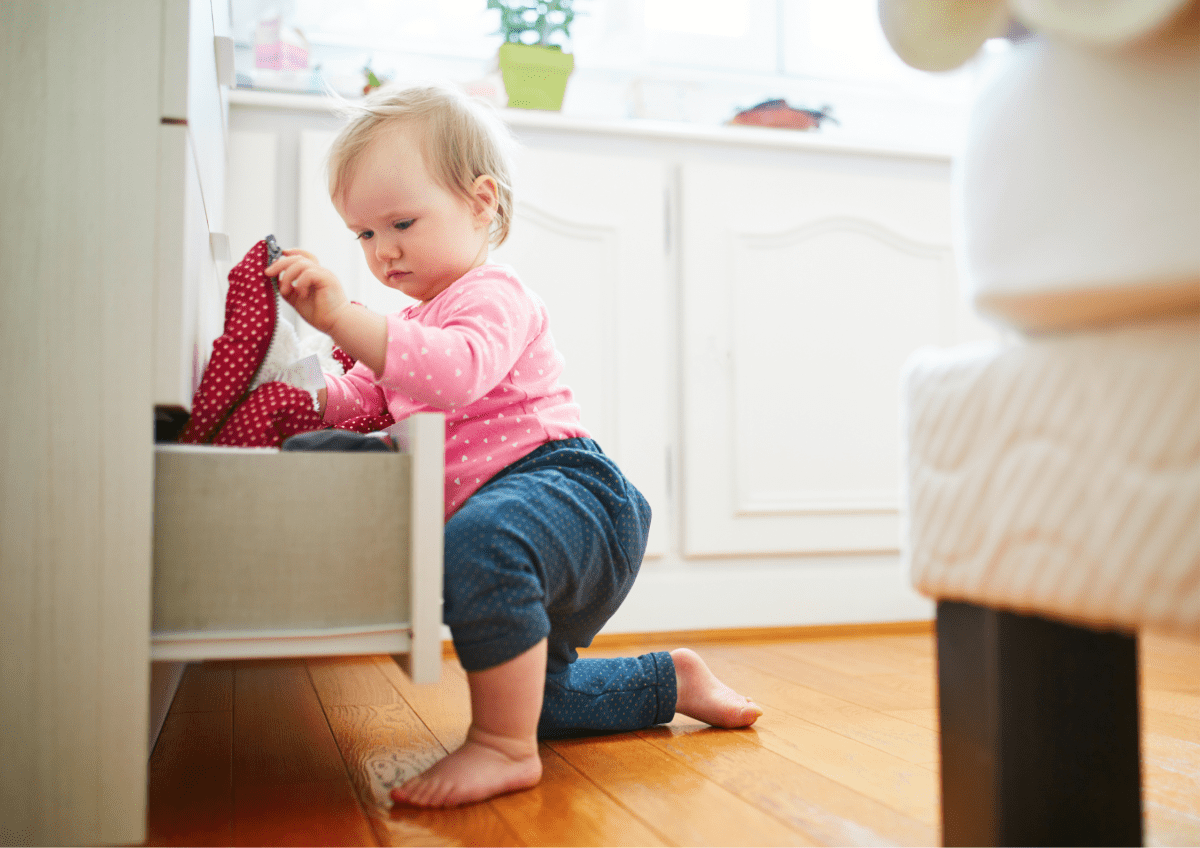
Your home is your baby’s playground. Every corner, every object, is a new adventure waiting to happen. But some adventures can be risky. Babyproofing helps keep those tiny hands safe and curious minds out of danger.
Don’t wait. Your baby’s next crawl, or curious grab could be toward something risky. Keep reading to protect them.
Contents
Why Allow Babies to Roam?
Babies are natural explorers. Letting them discover different parts of the home is essential for many reasons.
Brain Development – Moving freely boosts brain growth. It lights up neural pathways. This makes learning more easy as they grow.
Physical Skills – Crawling, walking, and climbing strengthen muscles. Babies learn balance. They also have perfect coordination.
Independence – Roaming helps babies feel confident. They learn to make their own choices. This early sense of autonomy is crucial for fostering independence.
Problem-Solving – When they encounter obstacles, they think. Maybe it’s about reaching for a toy or getting around a chair. Each challenge teaches them to solve problems.
Every step, crawl, or curious touch is a baby’s learning moment. Allowing them the freedom to roam gives them a head start on many essential life skills. As parents, our role is to strike a balance – ensuring they have the space to explore while ensuring that exploration is safe.
Assess the Rooms
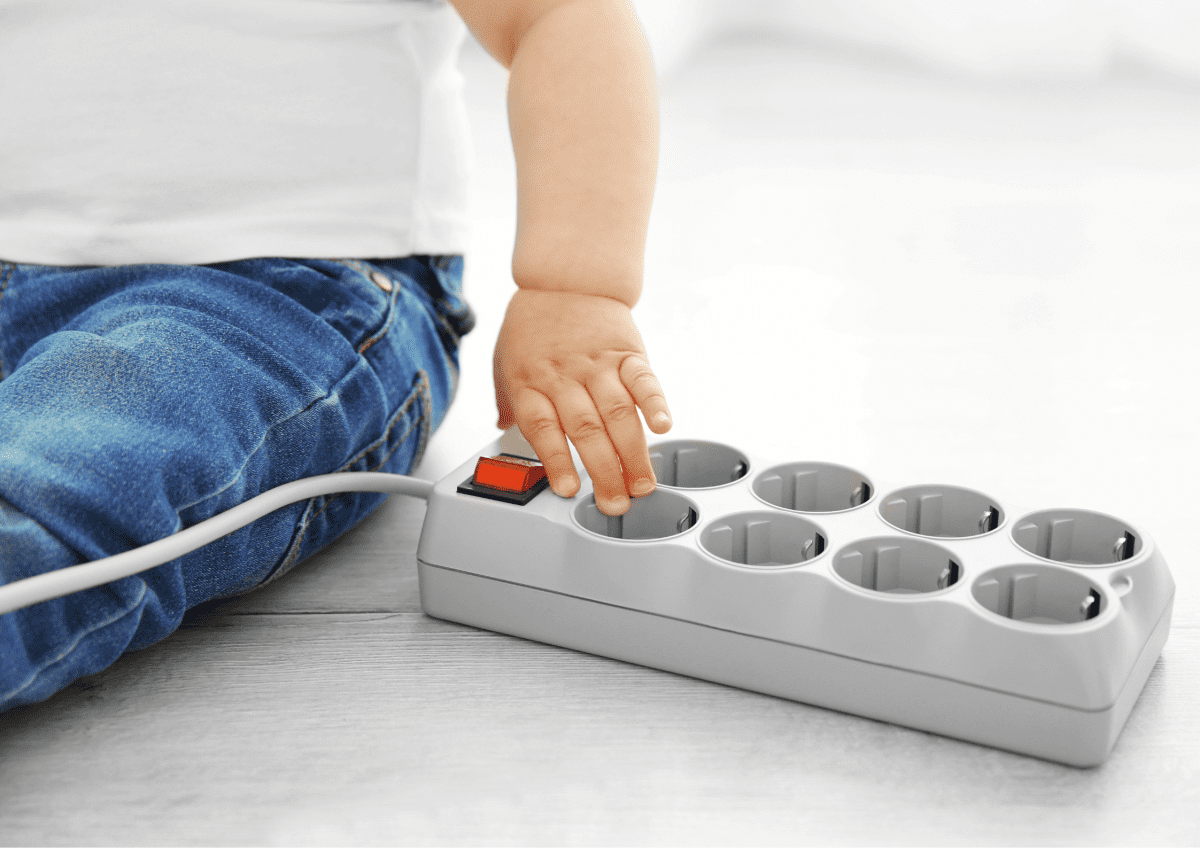
Before embarking on the babyproofing journey, it’s essential to understand the potential hazards each room presents. This section will help you identify what might harm your baby and provide solutions to turn danger zones into safe spaces.
Bedroom
Your little one’s bedroom is meant to be a sanctuary but can host several hidden hazards, which is a priority to your babyproofing plans.
- Loose crib sheets or bedding
- Small toys or objects within reach
- Unstable furniture like dressers or bookshelves
- Blinds or curtain cords within reach
- Outlets without covers
- Sharp edges on furniture
- Safety Solution: Furniture Anchors
Unstable furniture can easily tip over if your child tries to climb or pull themselves up. Furniture anchors are a simple yet effective babyproofing solution. Secure dressers, bookshelves, and other large furniture pieces to the wall.
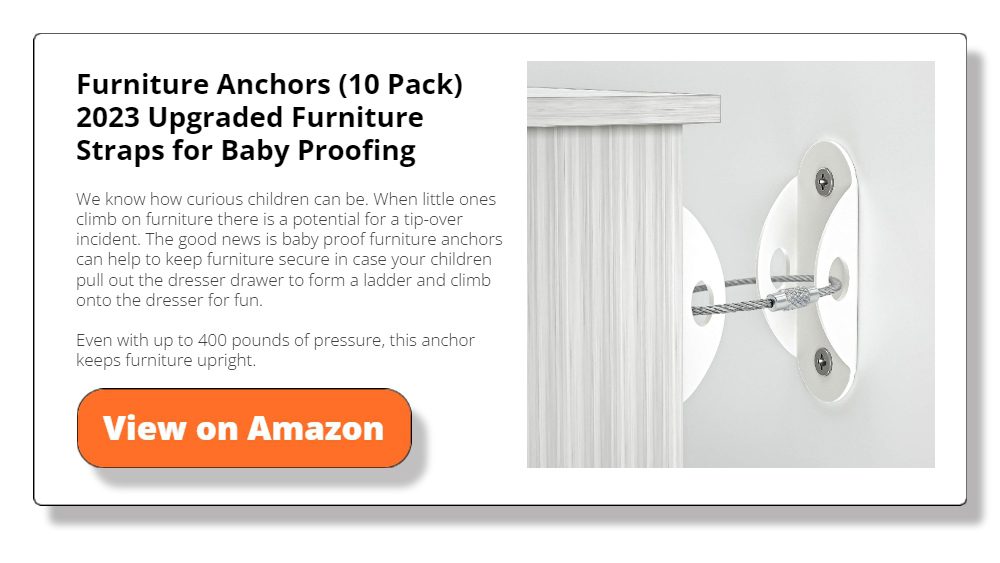
Living Room
The living room is often the heart of the home, where families come together. However, it’s also filled with potential risks for curious little hands.
- Electrical outlets and power strips
- Loose cords from lamps or electronics
- Coffee table with sharp corners
- Small items like remote batteries or decorative objects
- Fireplace tools and equipment
- Loose rugs or carpets that might trip a toddler
The allure of electrical outlets is undeniable to babies. Outlet covers are essential for the living room. These covers prevent curious fingers from poking inside, ensuring your child doesn’t experience any unwanted shocks.
Kitchen
Arguably the busiest room in the house, the kitchen is a hub of activity, but it also poses many potential hazards for babies.
- Sharp objects like knives or scissors
- Chemicals and cleaning supplies
- Hot surfaces like stoves or ovens
- Small objects like magnets or bottle caps
- Accessible trash bins
- Heavy pots or pans that can be pulled down
Cabinets can house various dangerous items, from chemicals to sharp tools. Investing in high-quality cabinet locks ensures these potential dangers remain out of reach. These locks are easy for adults to operate but tricky for tiny hands, making the kitchen safer.
Nursery
While designed for baby’s comfort, the nursery can still hide risks that might not be immediately obvious.
- Toys with small parts
- Long cords from baby monitors
- Mobiles or decorations hung too low
- Diapering products within reach
- Lightweight objects on shelves
Cords can be a strangulation hazard, whether from blinds or baby monitors. Cord shorteners or wind-ups can keep cords at a safe length, ensuring they’re out of reach and not a plaything for your child.
Bathroom
Bathrooms can be particularly treacherous for toddlers, with slippery surfaces and numerous hazards.
- Accessible cleaning chemicals
- Bathtubs without non-slip mats
- Unsecured toilet lids
- Sharp objects like razors
- Medications within reach
- Small objects like bottle caps or dental floss
Bath time should be fun, not risky. Non-slip bath mats provide a grippy surface for your baby, reducing the risk of slips and falls. These mats are easy to place in tubs and equally useful on bathroom floors.
Closet
Closets, while generally overlooked, can be a treasure trove of items that pique a child’s curiosity. But with this intrigue come potential dangers.
- Loose items that can topple when pulled
- Shoes with small parts like buttons or decorations
- Storage boxes that can trap a child inside
- Hanging cords or belts
- High shelves that may tempt climbing
- Chemicals or mothballs
To prevent young children from accessing potentially dangerous items in closets, door knob covers can be an effective babyproofing solution. Easy for adults to navigate, these covers prove challenging for little hands, keeping closets off-limits and their contents safe from curious exploration.
Garden
The garden, with its open space and nature’s touch, is enticing for kids. However, it can host a variety of hazards. This is an important space to consider babyproofing.
- Toxic plants or berries
- Garden tools and equipment
- Pesticides or fertilizers
- Small objects like pebbles or broken glass
- Ponds or water features that pose drowning risks
- Insects or animals that might bite or sting
Creating a dedicated play zone within your garden is a great way to ensure safety. Fenced play areas keep your child from potential hazards while allowing them to enjoy the outdoors. It’s a space where they can play freely under your watchful eye.
Patio
Patios can be an excellent extension of the living space, but they aren’t free from potential hazards for roaming kids if you have yet to consider babyproofing it.
- Loose or broken tiles
- Patio furniture that can tip over
- Grilling equipment or tools
- Access to stairs without gates
- Potted plants within reach
- Open railings or gaps
Safety gates are necessary if your patio has access points to areas like gardens or stairs. These gates ensure your child doesn’t wander off to potentially riskier parts of the home. Most gates are easy to install on most entry points.
Knowledge is the first step towards babyproofing your home. Recognizing the risks helps parents make informed decisions. Knowing the dangers in these rooms or parts of the house lets you keep your baby safe.
Risks in Baby’s Growth Stages
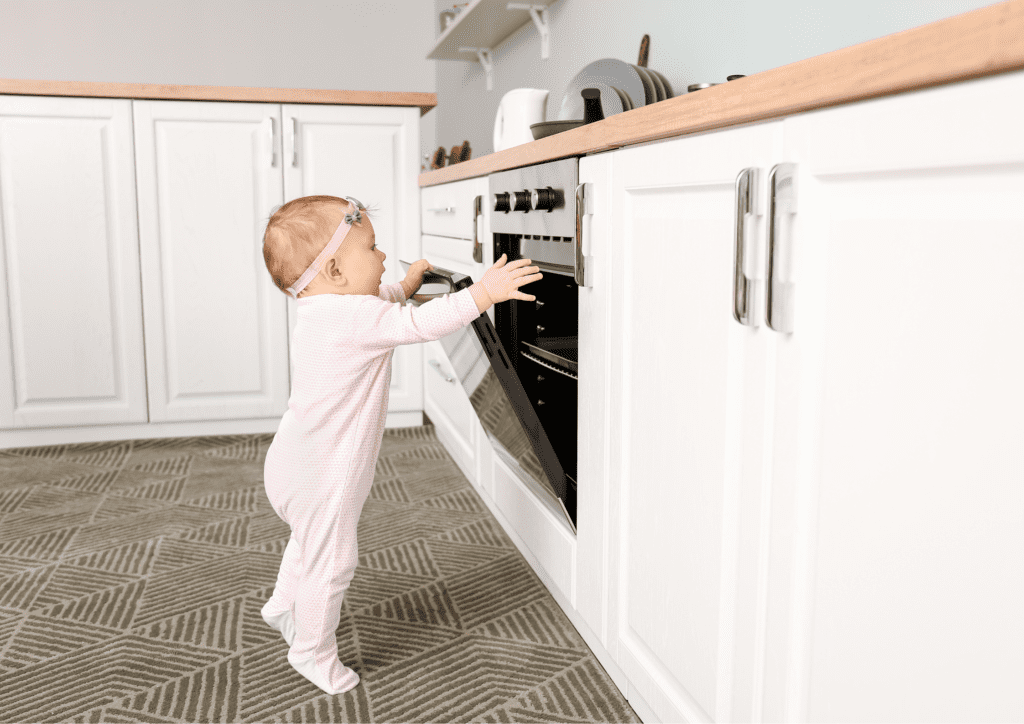
As your baby grows, so does their desire to explore and learn. But with each new developmental stage, new hazards emerge. Understanding these stages and their associated risks can help parents stay one step ahead.
Crawling
The moment your baby starts crawling, their interactions with their environment change drastically. Here are things to consider when babyproofing your space.
- Floor Hazards – Suddenly, everything on the floor becomes accessible. This includes small objects, dust, and pet food, which could be a choking hazard.
- Low Furniture – Babies use furniture to pull themselves up. Loose TV remotes, magazines, or unstable furniture pieces become risks.
- Electrical Outlets – At crawling height, uncovered outlets are a temptation and a significant electrical risk.
- Stairs – If your home has stairs, a crawling baby might be determined to conquer them, posing a risk of falls.
Baby gates should be one of the first investments when babyproofing your house. Placed at the top and bottom of stairs or to block off-risky areas, they create safe zones, restricting access to potentially dangerous places.
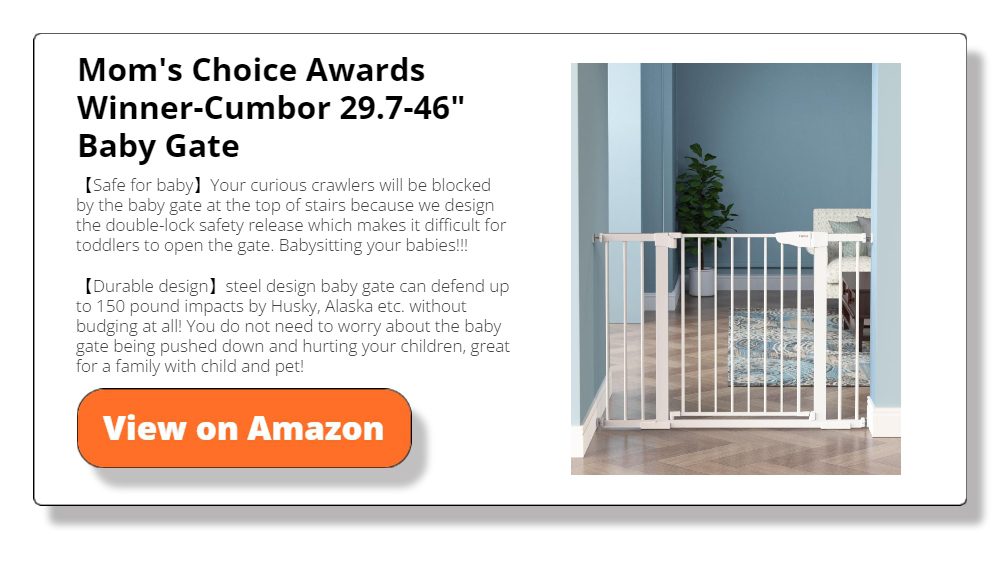
Walking
When those first steps are taken, your baby opens up a new world of mobility and interaction.
- Tipping Hazards – Now that your child is upright, they might try to use furniture to support their walking, potentially pulling items down on themselves.
- Doors and Cabinets – Their height allows them to reach door handles and cabinet knobs, leading to potential dangers inside or beyond those doors.
- Sharp Corners – Coffee tables, counters, and other furniture with sharp edges become a hazard if your child stumbles or falls.
- Windows – Your child might want to look outside, making low windows or those without secure locks a potential fall risk.
As your child starts walking, they’re bound to have a few tumbles. Corner protectors can be placed on sharp furniture edges, reducing the risk of cuts or bruises. These simple additions can make your home much more toddler-friendly when babyproofing their space.
Exploration
Children’s natural curiosity means they will eventually want to explore every nook and cranny of their environment. Babyproofing your home is crucial when they are at this stage.
- Hidden Items – Children love to dig and find. Drawers, purses, and storage areas can hide small objects that are choking hazards.
- Climbing – Whether it’s trying to scale bookshelves or climb onto counters, the world becomes a playground, and falls are a concern.
- Toilets and Tubs – Water is fascinating for kids, but toilets and tubs can pose drowning risks.
- Household Chemicals – Cleaning agents, medicines, or even certain plants can be toxic if ingested.
Children are naturally curious, and exploration is critical to their development. Safety latches on cabinets, drawers, and toilets restrict access to potentially harmful areas or substances. While adults can easily open them, they act as a first line of defense against your child’s curiosity.
Each point of their life comes with their joys and difficulties. As parents, watching our little ones reach milestones is a delight. But it’s equally important to anticipate and mitigate risks associated with each stage.
Do’s and Don’ts of Babyproofing
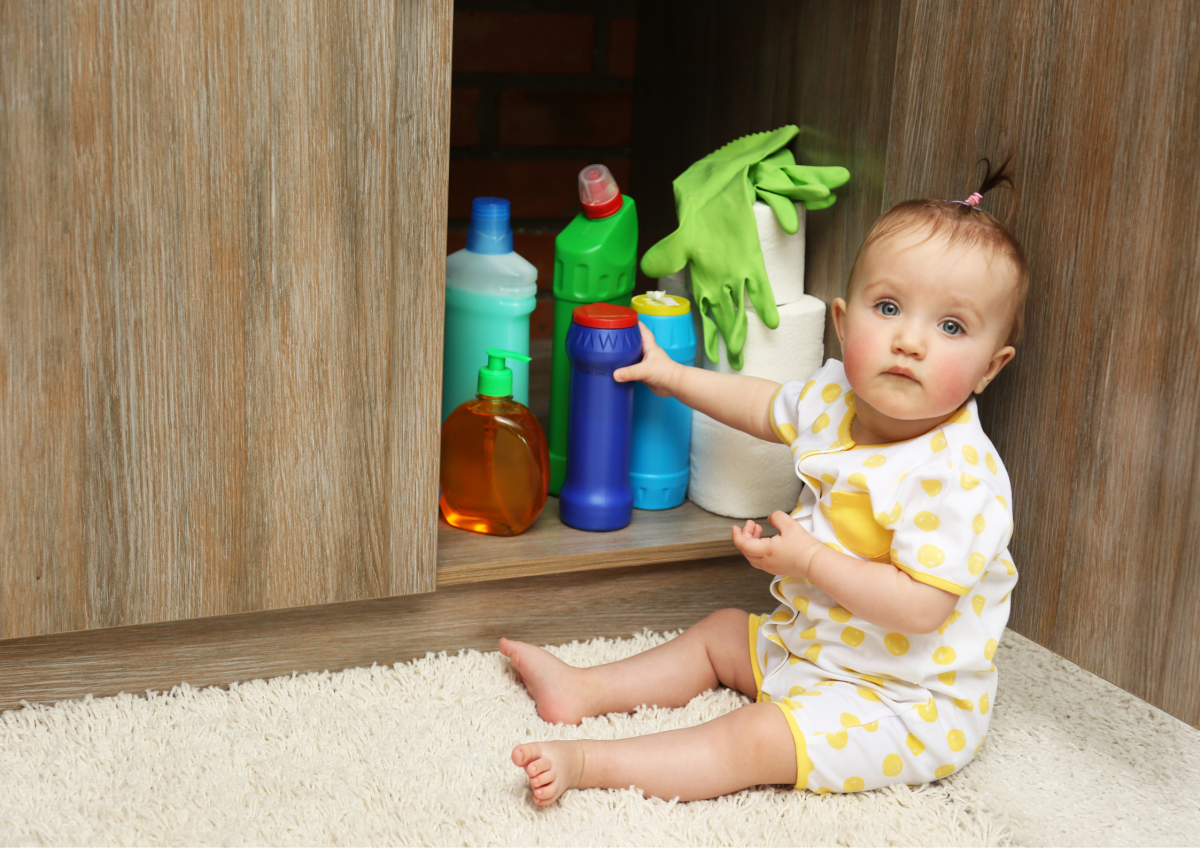
Babyproofing is an art. While it’s vital to ensure our homes are safe for our little ones, it’s equally crucial to strike a balance so that your home remains functional for adults. Here’s a quick guide to help parents navigate this balance, ensuring a safe yet livable environment.
Do’s
- Regularly Assess – As your child grows, their risks change. Regularly walk through your home to identify new hazards in your babyproofing plan.
- Prioritize Main Areas – Start babyproofing in areas where your child spends the most time and then branch out.
- Test Safety Products – Before relying on a safety product, test it. Ensure it works effectively and that older siblings can’t easily bypass it.
- Educate and Involve Siblings – If you have older children, involve them. Teach them about baby safety and how to do babyproofing when needed.
Don’ts
- Rely Solely on Baby Gates – While essential, they’re not a one-stop solution. Combine them with other safety measures in your babyproofing plan.
- Forget Windows and Balconies – It’s not just about ground-level risks. Ensure windows and balconies are secure to prevent potential falls.
- Overlook Small Objects – Choking hazards are everywhere. Regularly scan floors and accessible surfaces for tiny objects.
- Assume Safety – Even after babyproofing, always keep an eye on your child. No method is foolproof.
Babyproofing is a journey, not a destination. Our babies will face many challenges when they grow up. Keeping them in a bubble will endanger them over time. It is about letting them explore, learn, and grow in the safest environment possible. Embrace the process, adapt as needed, and cherish the peace of mind of a well-secured home.
Emergency Preparedness
Accidents happen, even when you diligently conduct babyproofing plans. This section will guide you in building a swift response when your baby is hurt.
Establishing an Action Plan
A clear, pre-established babyproofing action plan can be a lifesaver in those heart-stopping moments when an accident occurs. Here’s how to set one up:
- Stay Calm – Your reaction can influence the situation. Taking deep breaths helps. A calm demeanor not only aids in clear thinking but also soothes your injured child.
- Immediate Assessment – Quickly gauge the severity of the injury. Is it a minor cut, or does it look more serious? This assessment helps in determining the next steps.
- Basic First Aid Knowledge – Learn basic first aid. For minor injuries, cleaning wounds or applying ice might be enough. But knowing when to do what is crucial.
- Keep Emergency Numbers Handy – Have a list of essential numbers: pediatrician, local hospital, and a trusted neighbor or family member. Save them on your phone and keep a printed copy in an easily accessible area.
- Practice Drills – Regularly walk with older siblings or family members through the emergency steps. This ensures everyone knows their role and can act swiftly if needed.
- Emergency Kit – Keep a well-stocked first aid kit at home. Ensure it’s in a known and easily accessible location but out of reach of young children.
Preparing ensures your baby and everyone is safe when accidents happen. Accidents can and do happen. Being prepared ensures that you can handle them with confidence and care.
Emergency Kit Essentials
In the face of an emergency, every second counts. Having an emergency kit stocked with essential items ensures you can respond immediately, providing care and comfort to your child. Here’s a list of must-have items for your emergency babyproofing plan:
- Adhesive Bandages – Various sizes to cover small cuts or scrapes.
- Sterile Gauze Pads – Useful for covering larger wounds and helping with bleeding.
- Antiseptic Wipes – To clean wounds and prevent infections.
- Hydrocortisone Cream – Helps reduce inflammation or itching from insect bites or minor skin irritations.
- Tweezers – Essential for removing splinters or other small foreign objects.
- Digital Thermometer – To check for fever.
- Pain and Fever Medicine – Always consult your pediatrician regarding your child’s appropriate type and dosage.
- Saline Solution – Useful for cleaning out eyes or wounds.
- Instant Cold Packs – For bruises or swelling. Ensure they’re out of the baby’s reach, and always use a cloth barrier to protect the skin.
- First Aid Manual – A quick reference guide to handle various emergencies.
- Emergency Contact List – Include numbers of your pediatrician, nearest hospital, poison control, and other vital contacts.
- CPR Instructions – A small card or guide that provides step-by-step CPR instructions can be invaluable in a crisis. You can find printable CPR guides on numerous websites.
- Syringe or Medicine Dropper – Helpful for administering medicine.
- Nose Frida or Bulb Syringe – Clear nasal passages if your baby is congested.
- Allergy Medication – If your child has known allergies, always have their medication on hand. Remember to check expiration dates and consult with your pediatrician about dosages.
Remember, your emergency kit should evolve as your child grows. Regularly check and update the contents, ensuring products haven’t expired and remain relevant to your child’s age and needs. Safety and prompt action go hand in hand.
Safety is also about how you respond. By understanding potential risks and having a babyproofing plan, you’re prepared for and empowered by the unexpected. Equip yourself, educate your family, and ensure that your home remains a haven of safety and care even in emergencies.
Should You Call an Expert?
Every home has unique challenges, and babyproofing can be daunting. For some parents, the intricacies of their home’s layout and concerns about potential hazards make them consider seeking expert help. professional babyproofing brings experience, offering specialized insights tailored to a home’s specific needs.
Conversely, the DIY route can offer personal satisfaction and a hands-on understanding of your child’s environment. Many resources, from online tutorials to detailed guides, can empower parents to tackle the job effectively. Moreover, being directly involved in the process allows parents to make instant adjustments based on their child’s behavior and tendencies.
Ultimately, the decision concerns personal comfort, time, and budget. Whether you do it yourself or call in a professional, your child’s safety is always the priority.
Conclusion
Navigating the journey of parenthood is both a joy and a challenge, with each day presenting new adventures and learnings. Babyproofing your home is one of the essential steps in this voyage, ensuring your child’s world is as safe as it is stimulating.
Here’s to the little steps, the big milestones, and the peace of mind that comes with a well-protected home.








